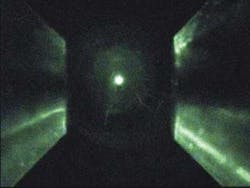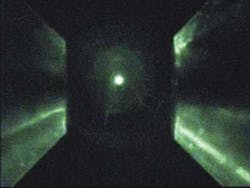Quantum dots lase in levitated microdrop
By levitating a spherical liquid microdrop doped with quantum dots in an electrodynamical trap and accessing the droplet’s surface-resonant modes, researchers at the Max-Planck Research Group and University Erlangen-Nuremberg (Erlangen, Germany) have managed to make a quantum-dot microdrop laser. A 400× power enhancement is observed in the surface-lasing modes as compared to the photoluminescence emission spectrum for the combined quantum-dot particles at the same wavelength.
The 9- to 40-μm-diameter microdropscomposed of water, 30%-by-volume glycerin to prevent evaporation, and a low concentration (1.3 to 2.6 μmoles) of cadmium selenide/zinc sulfide) core/shell quantum dotsare levitated in an electrodynamic endcap trap and pumped with a pulsed Nd:YAG laser (10 ns pulses, 10 Hz repetition rate). Single-mode lasing at 640 nm is observed in droplets less than 10 μm in diameter, while multimode lasing occurs in larger droplets. Incredibly, calculations based on a uniform distribution of quantum dots indicate that to achieve the nanowatt-level lasing signals observed, each quantum dot in the microdrop must contribute approximately 500 photons during a 10 ns pump pulse. The Erlangen team is now working toward understanding the lasing mechanism in more detail. Contact Jessica Mondia at [email protected].

